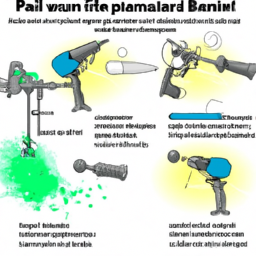How Paintball Guns Work An Overview
How Paintball Guns Work
How Paintball Guns Work
Introduction: Paintball Guns for Fun and Competition
Paintball guns provide hours of enjoyment for players young and old, and can be critical tools in competitive environments. While exhilarating paintball games exist in virtually every corner of the world, the mechanics of the guns that are used to engage in them are often curiously absent from the conversation. In this article, we will explore the nitty-gritty of paintball guns, delving into their physical components and tactical mechanics, as well as the history of their modern development.
The Physics of a Propulsion System
One of the most integral components of a paintball gun is its propulsion system, and the physics behind this system are at work regardless of the type of gun being used. During the propulsion process, propane gas is released from a gas tank connected to the gun handle, causing a chemical reaction with oxygen in the air. From here, the reaction releases a stream of hot pressurized gas through the muzzle of the gun, propelling the paintball out in the process. This reactive process requires a trigger-settling mechanism to ignite, allowing the gun to fire in the most advantageous and efficient fashion.
Types of Propulsion Systems
In general, there are two types of propulsion systems that are used in paintball guns: Nitrogen gas and Co2. While both fueling systems allow the gun to shoot at an impressive velocity and low recoil, Nitrogen gas is more reliable and easier to both install and maintain. While Co2 does still offer capable performance, the gun may require adjustments over time to ensure that performance does not dip and that firing is consistent; Nitrogen delivers on this front.
The Anatomy of a Paintball Gun
The barrel of a paintball gun provides long-range accuracy and is key to the performance of the weapon. The length of the barrel, as well as its interior bore size, will affect the accuracy of the gun both in area of impact spot as well as the round's trajectory. Most paintball guns feature an aluminum barrel, which provides excellent durability and airtight sealing, allowing shots to fire accurately and consistently dispersed.
Barrel Attachments
Barrel attachments, or barrel plugs, are used to increase accuracy over longer distances, and can be placed on the end of the barrel to add length or reduce the diameter. Weapon sights can also be used to enhance accuracy, giving users the ability to engage accurately over longer distances with improved sighting mechanics. Many modern paintball guns come packaged with these components integrated.
Tactical Applications of Paintball Guns
Modern paintball guns can be used to simulate the mechanics of traditional firearm combat in a safe and controlled environment. In competitive shooting situations, users will often utilize the same techniques they would with a firearm; such as establishing grip, forming stance, and capitalizing on cover if the situation allows. These techniques all help sharpen accuracy, allowing experienced players to pull off shots over longer distances with more precision.
Safety and Player Restrictions
Safety equipment such as helmets and heavy-duty clothing are essential for protective play. Similarly, high-velocity guns and grenades of any kind are highly restricted for the safety of all participants. Most competitive paintball fields, as well as smaller regional parks, will require all participants to abide by these safety regulations. A full safety briefing should be conducted before the commencement of any play.
Insights
Paintball guns are devices of unparalleled complexity, combining the mechanics of a traditional firearm with the physics of a hot gas propulsion system for enhanced accuracy and performance. Moreover, these weapons can be used for both fun and tactical training in a safe environment; which, with the inclusion of heavy-duty clothing and approved restrictions on weapons, makes paintball games both enjoyable and useful. Modern paintball guns are lightweight, offering enhanced maneuverability, accuracy and portability.

Previous Page
Next Page
